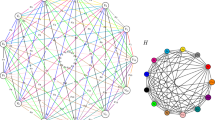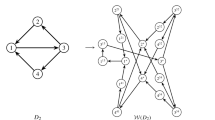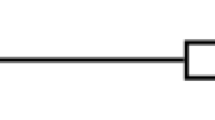Abstract
We aim to give more insights into adiabatic evolution concerning the occurrence of anti-crossings and their link to the spectral minimum gap \(\Delta _{\min }\). We study in detail adiabatic quantum computation applied to a specific combinatorial problem called weighted max k-clique. A clear intuition of the parametrization introduced by V. Choi is given which explains why the characterization is not general enough. We show that the instantaneous vectors involved in the anti-crossing vary brutally through it making the instantaneous ground-state hard to follow during the evolution. This result leads to a relaxation of the parametrization to be more general.








Similar content being viewed by others
References
Albash, T., Lidar, D.A.: Adiabatic quantum computation. Rev. Mod. Phys. 90, 015002 (2018). https://doi.org/10.1103/RevModPhys.90.015002
Altshuler, B., Krovi, H., Roland, J.: Adiabatic quantum optimization fails for random instances of np-complete problems (2009)
Childs, A.M., Farhi, E., Goldstone, J., Gutmann, S.: Finding cliques by quantum adiabatic evolution. Quantum Inf. Comput. 2(3), 181–191 (2002)
Choi, V.: The effects of the problem Hamiltonian parameters on the minimum spectral gap in adiabatic quantum optimization. Quantum Inf. Process. 19(3), 90 (2020). https://doi.org/10.1007/s11128-020-2582-1
Crosson, E., Farhi, E., Lin, C.Y.Y., Lin, H.H., Shor, P.: Different strategies for optimization using the quantum adiabatic algorithm (2014)
Farhi, E., Goldstone, J., Gutmann, S., Sipser, M.: Quantum computation by adiabatic evolution (2000)
Laumann, C.R., Moessner, R., Scardicchio, A., Sondhi, S.L.: Quantum annealing: the fastest route to quantum computation? Eur. Phys. J. Spec. Top. 224(1), 75–88 (2015). https://doi.org/10.1140/epjst/e2015-02344-2
Lucas, A.: Ising formulations of many NP problems. Front. Phys. 2, 5 (2014). https://doi.org/10.3389/fphy.2014.00005
Sun, J., Lu, S.: On the quantum adiabatic evolution with the most general system Hamiltonian. Quantum Inf. Process. 18(7), 1–11 (2019). https://doi.org/10.1007/s11128-019-2313-7
Wilkinson, M.: Statistics of multiple avoided crossings. J. Phys. A Math. Gen. 22(14), 2795–2805 (1989). https://doi.org/10.1088/0305-4470/22/14/026
Acknowledgements
This work was supported in part by the French National Research Agency (ANR) under the research project SoftQPRO ANR-17-CE25-0009-02 and by the DGE of the French Ministry of Industry under the research project PIAGDN/QuantEx P163746-484124. This work has also received funding from the European Union’s Horizon 2020 research and innovation programme under grant agreement No. 817482 (PASQuanS).
Author information
Authors and Affiliations
Corresponding author
Additional information
Publisher's Note
Springer Nature remains neutral with regard to jurisdictional claims in published maps and institutional affiliations.
A Appendices
A Appendices
To illustrate the intuition on the \(a_k\)’s, this graph (Fig. 9) is the same structure of the graph (Fig. 2) where nodes 1 and 3 are swapped as well as nodes 5 and 6. We keep the same weights vector \(w=[1,1,1,1.5,1.5,1.5]\).
For \(\alpha =0.2\), this produces the following final states according to their energy (Fig. 10a) and the eigenvalues evolution (Fig. 10b):
States a with their energy and \(E_i(s)\) b during evolution for toy example 9 with \(\alpha =0.2\)
With this instance, we observe that the final slope of \(E_0(s)\) comes from the slope of \(E_2(s)\); therefore, we expect that \(g_2(s)\) becomes dominant before transmitting to \(g_1(s)\) after the first anti-crossing between \(E_2\) and \(E_1\). Eventually, the anti-crossing of \(E_1\) and \(E_0\) will produce a crossing of \(g_1\) and \(g_0\). The latter will become dominant till being equal to 1 at the end. Now, focusing on the slope of \(E_0(s)\) before the anti-crossing, following the different successive anti-crossings, the jumps end up in the 4th energy level. In terms of \(a_k\)’s and \(b_k\)’s, this means that \(a_3(s)\) becomes important just before the anti-crossing and crosses \(a_0(s)\) at the anti-crossing. The same goes for \(b_3(s)\) and \(b_0(s)\). The plots below support these previous analyses.
\(a_k\) (a), \(b_k\) (b) and \(g_k\) (c) during evolution for toy Example 9 with \(\alpha =0.2\)
Remarks:
-
1.
In Fig. 11a, we only see one specific situation, namely the crossing of \(a_3\) with \(a_0\) at the anti-crossing point \(s^*\) between \(E_0\) and \(E_1\). This means that the curve \(E_0(s)\) was going toward the 4th energy level in terms of the slope before \(s^*\) and immediately change its slope toward its final direction of the 1st energy level. Hypothetically, we could observe \(a_3\) crossing \(a_1\), which will indicate that \(E_0(s)\) change its direction toward the 2nd energy level, then \(a_1\) crossing \(a_0\). In this hypothetical case, \(E_0(s)\) undergoes two anti-crossings.
-
2.
In Fig. 11b, we focus on the behavior of \(|E_1(s)\rangle \). Here, we understand that \(E_1(s)\) first went toward the 3rd energy level before changing direction toward the lowest energy level. This is \(b_2\) crossing \(b_0\) when the first anti-crossing between \(E_1\) and \(E_2\) occurs. Then, it takes the direction of the 4th energy level when \(b_0\) crosses \(b_3\). Indeed, it fetches the direction of \(E_0\) before anti-crossing (remember it was \(a_3\) which was dominant at this point). Then, again it takes back its initial direction with \(b_2\) becoming dominant at the second anti-crossing between \(E_1\) and \(E_2\). Eventually, it smoothly changes its direction toward its final goal.
-
3.
In Fig. 11c, the point of view is quite different as we look from the final lowest energy position \(E_0(1)\) and see from where it comes. We see in Fig. 10b that the final blue slope undergoes two anti-crossing before becoming blue. Indeed, it starts green and then jumps to red and finally blue. These successive anti-crossings appear on the plot of \(g_k\); first, \(g_2\) is dominant, and then at the first anti-crossing between \(E_2\) and \(E_1\), \(g_2\) crosses with \(g_1\). Now, the final slope of \(E_0\) is transported by \(E_1\). Eventually, \(E_1\) anti-crosses \(E_0\) so \(g_1\) crosses \(g_0\) and the evolution (at least for the ground-state) can finish peacefully.
Rights and permissions
About this article
Cite this article
Braida, A., Martiel, S. Anti-crossings and spectral gap during quantum adiabatic evolution. Quantum Inf Process 20, 260 (2021). https://doi.org/10.1007/s11128-021-03198-7
Received:
Accepted:
Published:
DOI: https://doi.org/10.1007/s11128-021-03198-7







